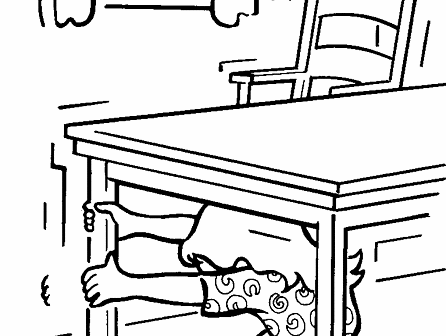As a California native, what to do in the event of an earthquake has been engrained into my head since I could remember. But now that I’ve lived out of California for a few years, those safety precautions have been pushed to the back of my mind. The recent earthquake here in Beijing was a good reminder that it doesn’t matter where you are because earthquakes can happen anywhere at anytime. Therefore, brushing up on general rules for safety can never be a bad idea.
Former United Nations Disaster Mitigation expert Doug Copp and current Rescue Chief and Disaster Manager of theAmerican Rescue Team International (ARTI) gives these tips for earthquake safety:
- Most everyone who simply “ducks and covers” when buildings collapse are crushed to death. People who get under objects, like desks or cars, are crushed.
- Cats, dogs and babies often naturally curl up in the fetal position. You should too in an earthquake. It is a natural safety/survival instinct. You can survive in a smaller void. Get next to an object, next to a sofa, next to a large bulky object that will compress slightly but leave a void next to it.
- Wooden buildings are the safest type of construction to be in during an earthquake. Wood is flexible and moves with the force of the earthquake. If the wooden building does collapse, large survival voids are created. Also, the wooden building has less concentrated, crushing weight. Brick buildings will break into individual bricks. Bricks will cause many injuries but less squashed bodies than concrete slabs.
- If you are in bed during the night and an earthquake occurs, simply roll off the bed. A safe void will exist around the bed. Hotels can achieve a much greater survival rate in earthquakes, simply by posting a sign on The back of the door of every room telling occupants to lie down on the floor, next to the bottom of the bed during an earthquake.
- If an earthquake happens and you cannot easily escape by getting out the door or window, then lie down and curl up in the fetal position next to a sofa, or large chair.
- Most everyone who gets under a doorway when buildings collapse is killed. How? If you stand under a doorway and the doorjamb falls forward or backward you will be crushed by the ceiling above. If the door jam falls sideways you will be cut in half by the doorway. In either case, you will be killed!
- Never go to the stairs. The stairs have a different “moment of frequency” (they swing separately from the main part of the building). The stairs and remainder of the building continuously bump into each other until structural failure of the stairs takes place. The people who get on stairs before they fail are chopped up by the stair treads – horribly mutilated. Even if the building doesn’t collapse, stay away from the stairs. The stairs are a likely part of the building to be damaged. Even if the stairs do not collapsed from the earthquake, they may collapse later when overloaded by fleeing people. They should always be checked for safety, even when the rest of the building is not damaged.
- Get Near the Outer Walls Of Buildings Or Outside Of Them If Possible – It is much better to be near the outside of the building rather than the interior. The farther inside you are from the outside perimeter of the building the greater the probability that your escape route will be blocked.
- People inside of their vehicles are crushed when the road above falls in an earthquake and crushes their vehicles; which is exactly what happened with the slabs between the decks of the Nimitz Freeway. The victims of the San Francisco earthquake all stayed inside of their vehicles. They were all killed. They could have easily survived by getting out and sitting or lying next to their vehicles. Everyone killed would have survived if they had been able to get out of their cars and sit or lie next to them. All the crushed cars had voids 3 feet high next to them, except for the cars that had columns fall directly across them.
- I discovered, while crawling inside of collapsed newspaper offices and other offices with a lot of paper, that paper does not compact. Large voids are found surrounding stacks of paper.




